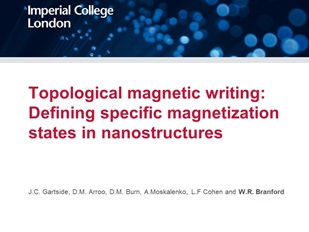
Topological magnetic writing: Defining specific magnetization states in nanostructures
J.C. Gartside, D.M. Arroo, D.M. Burn, A.Moskalenko, L.F Cohen and W.R. Branford
IoP Magnetism Manchester Apr 2018
Networks of magnetic nanostructures are of broad interest from novel data storage and computation to magnonic crystals. One family of nanomagnetic arrays, characvterized by strong and frustrated magnetic interactions are the artificial spin ices (ASI). ASI structures have provided vast amounts of physical insight in recent years [1,2,3,4] in part due to their ability to model complex systems [5] and exhibit exotic phenomena such as ‘magnetic monopole’-like states [6]. The power of these networks stems from the extraordinary number of unique microstates, even in systems comprising relatively few nanostructures. However, magnetic nanoarrays in general, and ASI structures in particular, have yet to realise their full potential as the majority of microstates remain inaccessible due to the rudimentary state-writing tools currently available. An experimental means to prepare all potential microstates has huge implications, including realising ASI as a tunable-bandgap magnonic crystal [7] or reconfigurable neural-network [8]. We present a novel MFM-tip based state writing technique, building on our previously demonstrated domain-wall injection process [9]. It requires no global fields and is applicable to all nanostructure architectures, providing control over the spin-configuration and access to every possible microstate. We demonstrate our method via realisation of several exotic and thus-far unobserved states, unachievable via global fieldprotocols: magnetic monopole-defect chains and the spin-crystal ground state [10] of kagome ASI.

Figure 1: i) Micromagnetic simulation and accompanying schematic of writing process dynamics showing positions of magnetic charges (±Q). ii) MFM image of ladder and zigzag monopole- defect chain states written at RT on a NiFe ASI lattice. iii) MFM image of the spin-crystal chiral ground state of kagome ASI written at RT on a NiFe ASI rosette.
[1] Wang, RF, et al. Nature 439.7074 (2006): 303-306.
[2] Branford, W. R., et al. Science 335.6076 (2012): 1597-1600.
[3] Zhang, Sheng, et al. Nature 500.7464 (2013): 553-557.
[4] Perrin, Yann, Benjamin Canals, and Nicolas Rougemaille. Nature 540.7633 (2016): 410-413.
[5] Qi, Yi, T. Brintlinger, and John Cumings. Phys. Rev. B 77.9 (2008): 094418.
[6] Ladak, Sam, et al. Nature Physics 6.5 (2010): 359-363.
[7] Heyderman, L. J., and R. L. Stamps. J. Phys.: Cond. Matt. 25.36 (2013): 363201.
[8] Wang, Yong-Lei, et al. Science 352.6288 (2016): 962-966.
[9] Gartside, J. C., et al. Scientific Reports 6 (2016)
[10] Anghinolfi, L., et al. Nat. Comms. 6 (2015).